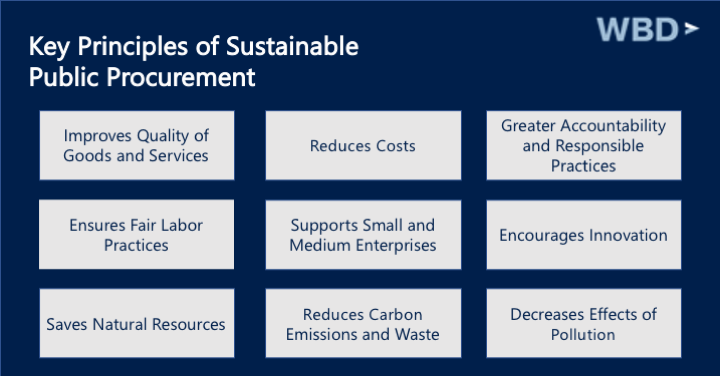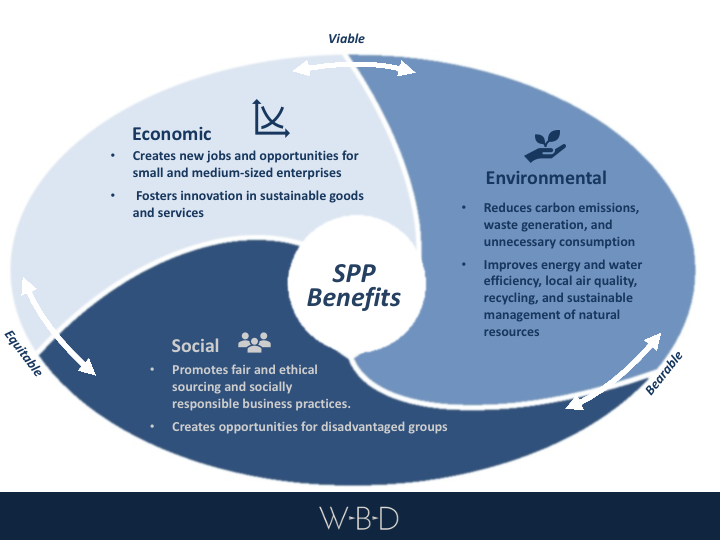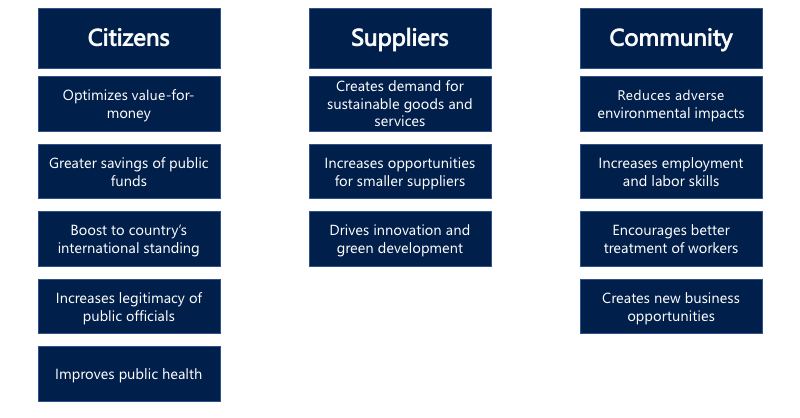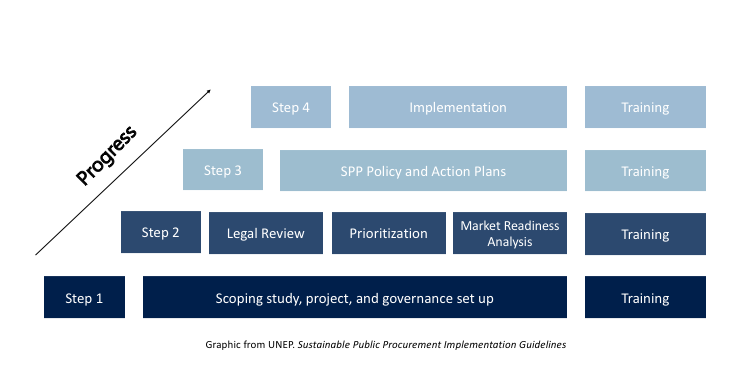<< Back to Media
Sustainable Public Procurement and WBD
January 11, 2021
I. Introduction
- What is Sustainable Public Procurement?
- Why is SPP Important?
- The Origins of SPP
II. SPP and the Investment Environment
- Adopting a Long-term Vision
- Creating Sustainable Economies
- Influencing the Good
III. How WBD Is Helping
- National Governments: Align with Country Development Plans
- U.S. Cities: Align with Urban Sustainability Directors Network
- Communication Strategy and Awareness
- Beyond Implementation: Measure, Report, Train, Repeat
I. Introduction
The international development community and many national and local governments know that the development approaches of past decades are not sustainable. While millions of people have been lifted out of poverty, poverty reduction has come at a tremendous environmental cost. The increase in demand for resources by a rising population has exploited the earth’s resources on an unprecedented scale and, in the process, has altered its climate. Unsustainable development activities in emerging and developed markets, such as deforestation, land use changes, and burning fossil fuels, have drastically increased greenhouse gasses, trapping heat and raising the Earth’s temperature.
“Amazon biodiversity also plays a critical role as part of global systems, influencing the global carbon cycle and thus climate change, as well as hemispheric hydrological systems, serving as an important anchor for South American climate and rainfall.” – Thomas Lovejoy for World Bank
The Amazon, for example, produces about half of its rainfall, delivering rain as far south as Argentina. Destruction of the Amazon rainforest to support industrialized farming, ranching, and mining negatively affects rainfall and agriculture throughout South America. Nearly 400 distinct indigenous peoples of the Amazon depend on the rainforest for their physical and cultural survival.
Thus, changes in biodiversity can disrupt entire ecosystems, resulting in the loss of goods and services that communities and emerging markets depend on to survive – and thrive. National governments’ policies and procedures for production and consumption play a significant role in determining future outcomes. To ensure the security, health, and prosperity of human communities, it is imperative to de-couple economic growth from environmental degradation and natural resource depletion.
The problems may seem intractable, but in fact, they are not. There are solutions—and one of them involves public procurement.
Responding to their precarious futures, taxpayers worldwide are increasingly holding governments accountable for spending public funds sustainably for their social and economic benefit. This includes people in developed and developing countries and is directed toward city, state, and regional government bodies.
In emerging markets, often the most vulnerable to a changing climate, citizens demand better value for their money. In response, multinational development banks and international development agencies have adopted sustainable development approaches to achieve better outcomes in their investments with partner countries. They emphasize public financial management to align spending processes to meet the UN Sustainable Development Goals (SDGs) by 2030.
On their own, donor agencies understand they lack sufficient resources to achieve sustainable development needs worldwide. The World Economic Forum states “a persistent $2.5 trillion annual financing gap” to achieve the SDGs by 2030. The focus is to help national governments in emerging markets fund their sustainable development strategies to end poverty and protect the environment. Public procurement is critical to this endeavor because public institutions and state enterprises must procure vast amounts of goods, services, and works to do their jobs. Therefore, how they carry out that duty can affect whether they can achieve their sustainable development goals. In addition, a well-governed and well-designed public procurement system generates trust and stability among the citizens it serves.
By harnessing sustainable consumption and production practices, WBD can help domestic and international governments, state-owned enterprises, and cities improve their economy, infrastructure, and other public goods and services while supporting fragile ecosystems and reducing carbon emissions.
What Is Sustainable Public Procurement?
Sustainable public procurement (SPP) is a process where public authorities balance what is good for society and the economy while reducing environmental damage. The underlying objective of SPP is to maintain balance among the three pillars of sustainable development: economic, social, and environmental. With each procurement transaction, government officials seek positive social, economic, and environmental impacts throughout the entire lifecycle of the goods and services – well beyond the upfront costs and including relevant financial and non-financial costs and benefits. Desired outcomes include expanding national and local markets for goods and services that support environmentally sustainable development (e.g., solar energy, recycled paper products, fresh local food for school lunches) and model “green” sustainable consumption practices and products for the wider public.
Fundamental SPP principles include promoting transparency and accountability throughout the lifecycle while ensuring sustainable consumption and production patterns supporting national development strategies.
Here are some essential ways SPP offers greater value for taxpayers’ money.

Why Is Sustainable Public Procurement Important?
Sustainable public procurement processes engender a more efficient, non-discriminatory, and transparent government spending system. The global average for a government’s public procurement is 10 to 15 percent of the country’s gross domestic product (GDP). That number can rise to 30 percent of GDP in developing countries. National defense, public transportation and infrastructure, and health care services are some of the goods and services that require government spending. Because of the government’s vast purchasing power, it can shape the direction of social progress and environmental protection.
For example, in the United States, three federal statutes require federal agencies to purchase energy-efficient products designated by the “Energy Star” certification and activate power management settings on government computers and monitors. This saves governments money and helps them meet energy-related goals. In turn, governments on board with SPP can influence the private sector to produce more sustainable goods and services, causing a multiplying effect for sustainable consumption and production.
However, any time governments spend money, pitfalls also exist. For example, public procurement transactions between public officials and the private sector are susceptible to corruption. A 2014 Organization for Economic Co-operation and Development (OECD) Foreign Bribery report reveals that more than half of foreign bribery cases occurred to obtain a public procurement contract. Government contracts, especially multi-year awards, are lucrative business opportunities for bidders and their vendors. Lower quality and higher cost goods and services are the direct result.
“Those paying the bribes seek to recover their money by inflating prices, billing for work not performed, failing to meet contract standards, reducing quality of work or using inferior materials, in case of public procurement of works.” – OECD, Preventing Corruption in Public Procurement, 2016.
To combat this, SPP transparency—in the form of easily accessible public records—is key. Greater transparency promotes greater accountability, which can lead to cost savings. Open access to records is critical to building stable civil societies where citizens can hold their elected officials accountable. SPP also paves the way for small and medium-sized enterprises (SMEs) to participate in the bidding process, strengthening the economy by increasing local job opportunities.
Overall, when government procurement policies and procedures emphasize social, economic, and environmental responsibility in their financial and life-cycle calculations, corruption risks decrease while transparency and non-discrimination in transactions increase.
In other words, SPP offers better value for taxpayers while improving the environment.
The Origins of SPP
The roots of sustainable public procurement can be traced to the 1992 United Nations Conference on Environment and Development in Rio de Janerio that called for a “new global partnership for sustainable development” by adopting an international approach to achieving sustainable consumption patterns. The conference, also known as the “Earth Summit,” produced a comprehensive plan of action, Agenda 21, that asked local and national governments to improve the “environment content” of their purchasing policies. Two years later, a roundtable at the 1994 Oslo Symposium came up with a working definition of “sustainable consumption and production” (SCP). The term refers to:
“The use of services and related products, which respond to basic needs and bring a better quality of life while minimizing the use of natural resources and toxic materials as well as the emissions of waste and pollutants over the life cycle of the service or product so as not to jeopardize the needs of future generations.” Oslo Symposium, 1994
Improved social and economic outcomes became intrinsically tied to sustainable environmental practices—detaching economic growth from environmental degradation—and have remained foundational to all future SCP policies and programs.
Launched in 2003, the UN-guided Marrakesh Process began implementing SCP projects with active participation from national governments, development agencies, civil society, and the private sector. The Swiss-led Marrakesh Task Force on Sustainable Public Procurement was launched in 2005 and lasted until 2011 as part of the Marrakesh Process to develop practical guidance on the SPP approach, produce research papers, encourage SPP dialogue among countries and stakeholders, and promote SPP training and assistance. The Marrakesh Task Force outlined its definition of and approach to SPP in a final report, attracting the support of several countries along the way.
In 2014, the UN Environment Programme (UNEP) supported the establishment of a global, multi-stakeholder platform for SPP implementation worldwide called One Planet Network Sustainable Public Procurement. One Planet, as it’s commonly known, co-leads the program to deliver the SPP message to more than 130 partner countries.
At the September 2015 United Nations Summit, all UN member states adopted the 2030 Agenda for Sustainable Development, with 17 Sustainable Development Goals (SDGs) and 169 targets with a plan to achieve them in 15 years. The Agenda is a commitment to eradicate poverty and achieve sustainable development by 2030 worldwide. SDG 12, “Responsible Consumption and Production,” calls for a systemic approach and cooperation among all stakeholders along the supply chain to achieve sustainable production and consumption patterns. One Planet Network works to achieve Goal 12 by engaging consumers through awareness-raising and education on sustainable consumption and lifestyles. Specifically, SDG 12.7 calls for promoting “public procurement practices that are sustainable, per national policies and priorities.”

II. SPP and the Business and Investment Environment
Adopting a long-term vision
All local and national governments procure goods and services – from paper and vehicles to waste management and road building. Making these purchases sustainable does not require more complex processes and procedures, nor does it have to be more expensive. Instead, a government’s move to SPP means adopting a new attitude and embracing a long-term vision, including:
- Committing to sound governance principles, which are inherently sustainability issues
- Ensuring transparency and accountability
- Protecting the environment
- Maintaining stable macroeconomic conditions
- Providing and maintaining good standards of public health and safety
- Mobilizing resources to provide essential public services and infrastructure
- Prioritizing long-term value-for-money over short-term, upfront costs. In cases where the upfront price might be higher, these costs can be recovered during the asset’s lifecycle through lower operational, maintenance, or disposal costs.
Overall, SPP considers a broader range of costs, such as management operations and maintenance costs, as it integrates social and environmental criteria into the procurement cycle.
By adopting an SPP process, a government’s public procurement mindset shifts toward the total cost of the asset or service over its entire lifecycle rather than the initial purchase price. This might also mean making the decision not to purchase or consume less rather than continuing to purchase the same amount but with different products or services.
Sustainable public procurement creates sustainable economies
Governments can use their purchasing power to shape their economies and societies in mutually beneficial ways. By creating increased demand for sustainable goods and services through SPP, governments can support the growth of SMEs through preferential bidding set-asides. Likewise, SPP can scale up new green industries in national economies with the ability to tap into the ever-increasing global demand for high-quality, sustainable products and services.
Adopting SPP can help local, regional, and national governments improve their reputations as transparent and reliable business partners to foreign investors, multinational development banks and donors, and the private sector. Stable domestic markets attract foreign direct investment. In a recent World Bank report, foreign investors cited “supportive political environments, stable macroeconomic conditions, and conducive regulatory regimes as their top three investment decision factors — even more important than low taxes, low labor and input costs, or access to natural resources.” SPP can also spur private sector investment for green and climate-friendly initiatives. In emerging markets, governments that adopt SPP can secure international financial support through the UN’s Nationally Appropriate Mitigation Actions, which refers to “any action that reduces emissions in developing countries and is prepared under the umbrella of a national governmental initiative.” The Global Environment Facility, administered by the World Bank, also funds projects in “developing countries and countries with economies in transition to meet the objectives of the international environmental conventions and agreements.”
Other financial benefits include outstanding value-for-money for goods, services, and infrastructure. For example, by placing greater emphasis on long-term utility costs—water, heating, and electricity use and maintenance—operational savings are incurred through improved insulation, reduced leakage, and other efficient water and electricity measures. Choosing products and services that are environmentally friendly can reduce operational costs in waste management and public health. Selecting higher-quality products with longer lifespans can also provide greater value for money.
Success Story from European Commission, February 2020
The Procurement of Green Electricity in Koprivnica, Croatia.
Within the Intelligent Energy Europe project, the city of Koprivnica in Croatia decided to supply seven public buildings and street lighting with green electricity. The city included green public procurement criteria in the tender specifications, indicating a minimum of 20 percent of renewable energy and decided to use the most economically advantageous procedure instead of the lowest price as only award criterion, allowing that 10 percent of the award points would go to the bidder with the greenest electricity offer.
The procedure was more successful than anticipated with a 100 percent green electricity supply by the winning bidder. This resulted in 1,333.85 tonnes of CO2 saved on an annual basis, 385 tonnes of oil equivalent of renewable energy triggered, and an investment of 193,500,00 €.
European Commission. Brussels. “Public Procurement of Energy Efficient Works, Supplies, and Services.” 2020.
Adopting SPP furthers the development of a circular economy – an alternative to the traditional linear economy of “make, use, dispose.” In a circular economy, resources are used as long as possible, their maximum value is extracted while in use, and then they are recycled, remade, and reused as something new at the end of their lifecycle.
The Business Case for Sustainable Public Procurement

But SPP is not just about purchasing in ways that reduce cost and achieve value for money. By adopting and implementing an SPP policy, local and national governments can achieve wider social and environmental policy objectives.
Effects of SPP
Purchasing actions have social implications. Adopting SPP can improve the ethical behavior of public officials, suppliers, and contractors. It can advance living standards by improving employment, working conditions, labor standards, air and water quality, and reducing the harmful effects of pollution and carbon emissions. It can conserve natural resources for future generations. A move to SPP might mean purchasing at the same levels but with a different set of criteria—or not purchasing at all, with a new mindset to consume less.
Past methods of increasing GDP, incomes, or employment levels no longer mean greater resource extraction and pollution. National and local governments are increasingly striking a better balance in de-coupling economic growth with resource extraction, and SPP is playing a large role in their efforts. The Global Review of Sustainable Public Procurement 2017 from the UNEP confirms that both national and local governments are adopting and successfully implementing and maintaining SPP in ever-growing numbers. One Planet Network reports that more than 500 stakeholders, including governments, are engaged in its programs.
Economic Impact — improve business enabling environment, greater value-for-money, more FDI and private sector investment
Social Impact — create employment opportunities, improve labor conditions, decrease public sector corruption, healthy environment, better, cleaner, and safer public goods and services
Environmental Impact — reinforces sustainable supply chains, improves renewable energy, protects and conserves natural resources, reduces carbon emissions.
III. How WBD is Helping
Washington Business Dynamics (WBD) helps public officials in both US and international cities, states, and national governments design, implement, measure, and monitor a public procurement policy for their citizens. WBD is a management consulting firm specializing in procurement, strategic advisory services, and international development. With decades of experience delivering solutions in a diverse set of environments, the team at WBD will work with you a partner to achieve the institutional changes, operational performance enhancements, and sustainable processes you need to make a difference.
In Indonesia, for example, WBD helped the Indonesian government create a cadre of professional procurement officials with the appropriate skills, systems, processes, and operating standards to reduce costs and achieve efficiency in procurement.. Our team of consultants, in close partnership with the Government of Indonesia and the Millennium Challenge Corporation, addressed a public procurement system that, according to the Indonesian government, “lacked consistency, governance, and expertise and was highly vulnerable to waste and abuse.” At the end of the 2-year project, WBD succeeded in significantly improving procurement quality and processes across 44 different Indonesian offices nationwide.
Millennium Challenge Corporation – Indonesia Compact
The Procurement Modernization Project
The Project: WBD supported the Millennium Challenge Account – Indonesia (MCA-I) with a major public procurement capacity building project. This effort started in 2015 and spanned over three years. Under WBD’s technical direction, the project developed and delivered over 30 training modules to over 1000 procurement professionals and auditors, exceeding the project goals and targets. WBD also developed a team of skilled and committed local trainers who were able to sustain the training program at a professional level.
WBD provided support to 44 different Indonesian government procurement offices across the country. Specific capacity building support included: the development of 18 core competency training modules; the development of 12 specialty training modules; the creation of workshop materials and knowledge products; the development of mentoring case studies; and the assessment of capacity development for individual participants and government offices as a whole.
WBD worked directly with local Indonesian procurement officers to create bespoke case studies and group activities that accounted for the unique capacity development needs of each office. WBD also conducted a comprehensive review of each government office’s operations, staff profiles, existing resources, and existing capacity. WBD measured existing capacity through a combination of knowledge exams and assessments of individual professional competency for the practical application of required skills. Additionally, WBD focused on the viability and sustainability of the project, to ensure its eventual transition to local resources.
As part of the overarching capacity building project, WBD provided different Ministries with best practices in such areas as category management, for optimizing value-for-money. Our capacity development support also extended to the various regional contracting offices that handle purchasing for the health care system. Much of the Public-Private Partnership-related support WBD provided included improving access and maintaining/lowering costs; increasing the availability of care in rural areas; and addressing supply chain challenges for certain types of pharmaceutical care (e.g., HIV treatment).
Project Results: At the end of the project, 40 out of 44 government offices exhibited signs of major development in procurement capacity. The remaining four offices showed a significant degree of capacity development. With an eye toward the future, WBD developed a major sustainability plan for the Indonesian government across all offices that included additional planning for civil servants to carry training to other municipal offices.
Millennium Challenge Corporation. August 2019. Indonesia Compact: Executive Summary
National Governments: Align with Country Development Plan
For national governments, our procurement, analytics, training, and communication experts will work with government officials to launch a national SPP Policy and Action Plan in alignment with the “SPP Approach” that emerged from the Marrakesh Task Force and was backed by UNEP. The SPP Approach, co-led by UNEP and One Planet Network, provides governments with a vision and language shared by the international community and offers a tested framework on how to implement SPP effectively based on shared practices and lessons learned from governments that have already done so.
In addition to providing international standards, WBD will organize peer reviews from international experts in SPP to assess the current procurement system and present proposals to address implementation gaps. The reviews will build consensus among government officials and between officials and the private sector in policy dialogues, especially on how SPP benefits SMEs. These conversations will build consensus to support the forthcoming SPP Policy and Action Plan and lead to the forming of an SPP community of practice around international standards to shape procurement reforms.
In keeping with the OECD implementation guidelines, WBD will facilitate training at each of the four steps of the implementation process. WBD will work with government to help:
Step 1 — Launch the SPP project, establish project governance, and conduct initial training.
Step 2 — Undertake a status assessment, legal review, prioritization exercise, and market readiness analysis.
Step 3 — Do strategic planning and create an SPP Policy and Action Plan.
Step 4 — Implement SPP throughout the procurement cycle.
A WBD SPP Policy and Action Plan will provide a mandate and clear direction for implementation. Successful implementation requires coordination and cooperation across various government agencies and regional boundaries. WBD will ensure that an SPP Policy and Action Plan incorporates a country’s unique economic, social, and environmental objectives in alignment with overarching development plans.
U.S. Cities: Connect with Urban Sustainability Directors Network
In the United States, WBD will create city SPP policy and action plans in close cooperation with the Urban Sustainability Directors Network (USDN). Directed and led by its members, the USDN now represents over 200 communities of nearly 90 million residents across the U.S. and Canada. The USDN’s primary mission is to connect local government practitioners to accelerate urban sustainability in U.S. and Canadian communities. This uniquely North American SPP community of practice emphasizes peer exchange and collaboration between local government sustainability leaders.
USDN governments are leading the way to a sustainable, low-carbon future by developing, adopting, and sharing practices that create equitable and prosperous communities and a healthy environment. – USDN Vision
Here at WBD, we understand and appreciate that sustainable procurement is not standardized among U.S. cities. We work to help cities create and launch a SPP program that addresses the social, economic, and environmental issues within the context of their unique local, state, and national needs. Yet we also connect cities so they might benefit from sharing:
- market research
- model policy and bid specification language
- effective program designs and procurement strategies
- successful education and outreach approaches
- practical tracking and reporting procedures
The city SPP action plans developed by WBD in partnership with local U.S. governments are guided by the actions outlined in the Sustainable Procurement Playbook for Cities developed by the USDN.
Communication Strategy and Awareness
A key feature of SPP implementation rests on practical communication tools to raise awareness and disseminate information among all stakeholders, including public officials, organizations, the private sector, and all citizens. WBD has a proven record of organizing workshops and trainings to promote a national campaign, including public procurement. Our team of communication experts can create and distribute bespoke information materials at these events and help to craft public service announcements on social media, television, and radio.
Beyond Implementation: Measure, Report, Train, Repeat
Whether for national governments or U.S. domestic cities, the action plans created by WBD in partnership with national or local governments will specify the policies and procedures to continuously monitor and measure success. These include how to identify indicators of success, measure progress, continue to build capacity through regular training where necessary, and, for UN member states, how to report on SDG 12 with the appropriate indicators, outcomes, and impact. By creating an SPP community of practice and building consensus among all stakeholders, WBD will leave a legacy of SPP professionals to carry on procurement reforms well into the future.
***
Author: Mary Jane Maxwell, Ph.D., Senior Expert at Washington Business Dynamics

